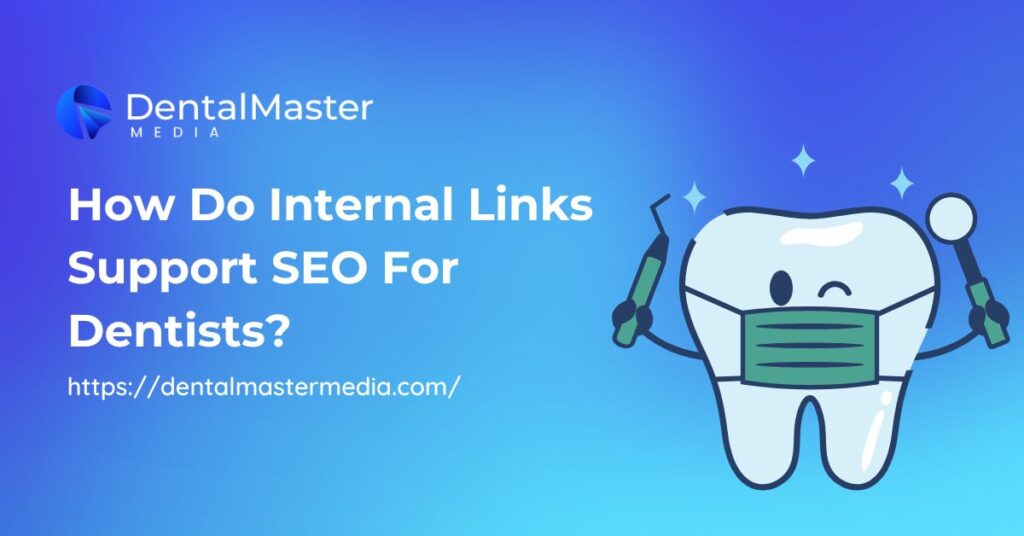When a person lands on your website, they need clear paths to answers: “Do you offer braces?”, “How fast can I book an emergency visit?”, “What do dental implants cost?”
Internal links are the signs that point them to the right rooms. They connect your pages, guide visitors step by step, and help search engines read your site like a clean map.
Think of internal links as your site’s bloodstream. They move visitors and page value to the places that matter most,your services, locations, and booking pages.
They also help search engines discover, understand, and rank those pages. Done well, internal links make your site easier to use and easier to trust. In short, they are a quiet workhorse for SEO For Dentists.
What Are Internal Links?
A simple definition and examples
An internal link connects two pages on the same site, like “Dental Implants” linking to “Bone Grafting.” These links guide visitors to the right service and build context.
For example, a blog on tooth pain linking to “Root Canal Treatment” shows both readers and search engines the right solution. This approach is often used by the Best Dental SEO Company to boost visibility.
Main types (navigation, footer, breadcrumbs, contextual)
Navigation links sit in the header menu, guiding visitors to core pages like “Treatments” or “Contact.”
Footer links repeat at the bottom, covering legal info and key services as a safety net.
Breadcrumbs show a page’s position, like “Home > Services > Orthodontics,” helping users and crawlers.
Contextual links appear in content, pointing readers directly to related pages such as “Clear Aligners” or “Aftercare.”
Why Internal Links Matter for Dental SEO
Help patients find care faster
People make quick choices online. Clear links reduce confusion and save time. If a parent reads a guide about signs that a child might need braces, a link to your “Braces for Kids” page lets them move from learning to booking in seconds.
When a patient can follow a simple path,guide to service to booking,you remove friction and protect that potential appointment.
Help search engines discover and understand your pages
Search engines crawl your site by following links. When a page receives several internal links, crawlers find it more often and can better understand what it covers.
The clickable words in your link, called anchor text, act like labels. If many pages point to “Root Canal Treatment” using clear wording, it becomes easier for a crawler to match that page with the right searches.
Spread page authority across your site
Some pages gain strength because they attract visits, references, or press. Internal links allow that strength to flow to other pages that need a lift.
Over time, this helps your service pages and location pages hold steadier positions. It is like moving water through a network of pipes.
You do not want all the pressure stuck at one tap; you want it reaching every room that matters.
Build a Clear Site Structure
Service hubs and related “spoke” pages
A hub-and-spoke model keeps things tidy. Create a hub page for each major treatment area. For example, “Orthodontics” can be your hub.
From there, link to focused spokes such as “Metal Braces,” “Ceramic Braces,” “Clear Aligners,” “Retainers,” and “Braces for Kids.”
On each spoke page, add a link back to the hub and, where it helps, a link to a sibling page. Someone learning about aligners will likely want to know about retainers, so connect those pages.
This cluster tells readers, and crawlers, that you cover the topic in depth. It also keeps visitors inside your site because every natural next step sits one click away.
Location pages linking to services and vice versa
If you serve more than one area, make location pages that list services actually offered there.
From each service page, link back to the matching location page. This pairing answers a common question: “Is this available near me?”
It also helps search engines match local searches with the right page. Clarity in both directions,service to location and location to service,keeps the path simple.
Blog posts pointing to the right service pages
Blog posts explain problems and answer early questions. Use them to guide readers to the correct treatment.
A post on “How to stop tooth pain at night” can point to “Emergency Dentistry” and “Root Canal Treatment.”
A post on “How clear aligners work” can point to “Clear Aligners,” “Costs and Financing,” and an “Aftercare” guide. When you place these links inside helpful sentences, readers feel supported rather than sold to.
Anchor Text That Works
Be descriptive, not vague
“Click here” or “Read more” does not tell anyone what is on the other side. Use words that match the destination, such as “Wisdom Tooth Removal,” “Dental Cleaning,” or “Gum Disease Treatment.”
Descriptive anchors help readers choose the right path and help crawlers learn what each page covers.
Keep it natural and varied
If every link repeats the exact same phrase, reading becomes stiff. Keep it natural while staying clear.
For a page about root canals, you might use “root canal,” “root canal treatment,” or “save a damaged tooth.” This variety feels human and still delivers a strong topic signal.
Accessibility and screen readers
Some visitors use screen readers. Clear link text helps them move through your site with confidence.
Write anchors that stand on their own, so the meaning is obvious even if someone hears the links read aloud in a list.
Link Placement, Depth, and Fixing Orphan Pages
Where to place links so people use them
Place links next to the sentences that spark action. If you list symptoms of gum disease, add a link to “Gum Disease Treatment” right after the symptoms.
If you explain what happens during a cleaning, add a link to your booking page in the paragraph that covers timing and comfort. Links should sit where questions arise and where the next step feels natural.
Keep important pages close to the homepage
“Click depth” is the number of clicks from the homepage to a page. Keep key pages within one or two clicks.
Add them to your main menu if needed, or link them from your hubs. Shorter paths help visitors and make it easier for crawlers to check these pages often.
Find and fix orphan pages
An orphan page has no internal links pointing to it. People cannot find it easily, and crawlers may ignore it. Once a month, list your pages and mark any that receive zero or very few internal links.
Add links from related hubs, service pages, or popular blog guides. Even one strong link can bring an orphan back into view.
How Many Internal Links per Page?
Quality over quantity
There is no magic number. Ten helpful links are better than thirty random ones. Each link should have a purpose.
Ask yourself, “Does this link help someone decide, compare, or book?” If yes, keep it. If not, remove it. Clean, purposeful pages build trust, simplify choices, and support growth when paired with Expert Dental SEO Services.

Measuring Impact
Crawl, index, and engagement signals to watch
Use search console to check crawl stats,after improving internal links, key pages often get crawled and indexed more. Review index coverage to see if hidden pages now appear.
In analytics, watch time on page, scroll depth, and clicks to booking. A smoother link path, from blog to service to booking, usually lifts engagement.
Example checkpoints for clinics
Your “Emergency Dentist” page should be one click from the homepage and linked from guides on tooth pain or broken teeth.
The “Orthodontics” hub must link to all child pages and receive links back. Each location page should connect to its services, and each service page should link back to the right location. This clear structure helps both visitors and crawlers.
A 30-Day Internal Linking Plan
Week 1: Map your content
Make a simple inventory. List your main services, supporting guides, and location pages. Group them by theme, such as implants, orthodontics, hygiene, or emergencies.
Under each theme, note the pages that should form the hub and the spokes. This written map becomes your plan.
Week 2: Structure your hubs
Turn each theme into a hub with clear links to every spoke. On each spoke, add a link back to the hub and to the next logical step.
For example, an aligner page should point to retainers and to an aftercare guide. Keep the language plain and the path predictable.
Content teams, including those at Dental Master Media, often follow this flow because it keeps readers moving without confusion.
Week 3: Add and improve links
Open your top ten blog posts and add two or three precise internal links where they help most. Fix any vague anchors.
If a sentence explains what to do about night tooth pain, link the phrase “Emergency Dentistry” inside that sentence.
If a paragraph explains deep cleaning, link to “Gum Disease Treatment” immediately after it. Each link should feel like a friendly hand pointing to the right door.
Week 4: Review and adjust
Check click depth for your key pages. If a page sits three or more clicks from the homepage, pull it closer by linking from a hub or the main menu.
Look for orphan pages and give them at least one strong internal link from a related page. Re-read your anchors and replace any that feel vague or repetitive. Small fixes add up fast.
Common Mistakes in Dental SEO
Using vague anchors like “click here” weakens dental SEO. Avoid repeating the same link text, overloading pages, or leaving orphan pages.
Connect services with locations, fix broken links, and keep paths clear for patients and search engines.
Conclusion
Internal links shape clear paths from questions to answers and help more visitors reach the pages that matter for care and bookings.
They guide readers from a guide to a service to a simple way to contact your team. If you would like a hand building a tidy hub-and-spoke structure and refining anchors that feel natural to real people.
Dental Master Media can help you plan, implement, and review a linking model that supports steady, reliable growth.

Suraj Rana is the owner of Dental Master Media and a leading expert in SEO for dental practices. With a passion for dental marketing, he has successfully helped numerous dental clinics climb the search engine ranks. Suraj’s expertise makes him a go-to resource for effective, results-driven dental marketing.

